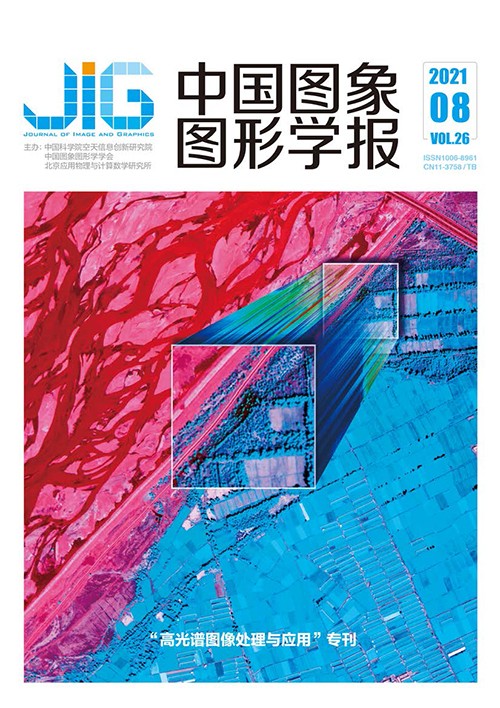
傅里叶变换通道注意力网络的胆管癌高光谱图像分割
郑少佳1,2, 邱崧1,2, 李庆利1,2, 周梅1,2, 胡孟晗1,2, 于观贞1(1.华东师范大学上海市多维度信息处理重点实验室, 上海 200241;2.华东师范大学空间信息与定位导航上海高校工程研究中心, 上海 200241) 摘 要
目的 胆管癌高光谱图像的光谱波段丰富但存在冗余,造成基于深度神经网络高光谱图像分割方法的分割精度下降,虽然一些基于通道注意力机制的网络能够关注重要通道,但在处理通道特征时存在信息表示不足问题,因此本文研究构建一种新的通道注意力机制深度网络,以提高分割准确性。方法 提出了傅里叶变换多频率通道注意力机制(frequency selecting channel attention,FSCA)。FSCA对输入特征进行2维傅里叶变换,提取部分频率特征,再通过两层全连接层得到通道权重向量,将通道权重与对应通道特征相乘,获得了融合通道注意力信息的输出。针对患癌区域和无癌区域数据不平衡问题引入了Focal损失,结合Inception模块,构建基于Inception-FSCA的胆管癌高光谱图像分割网络。结果 在采集的胆管癌高光谱数据集上进行实验,Inception-FSCA网络的准确率(accuracy)、精度(precision)、敏感性(sensitivity)、特异性(specificity)、Kappa系数分别为0.978 0、0.965 4、0.958 6、0.985 2、0.945 6,优于另外5种对比方法。与合成的假彩色图像的分割结果相比,高光谱图像上的实验指标分别提高了0.058 4、0.105 8、0.087 5、0.039 0、0.149 3。结论 本文所提出的傅里叶变换多频率通道注意力机制能够更有效地利用通道信息,基于Inception-FSCA的胆管癌高光谱图像分割网络能够提升分割效果,在胆管癌医学辅助诊断方面具有研究和应用价值。
关键词
Fourier transform channel attention network for cholangiocarcinoma hyperspectral image segmentation
Zheng Shaojia1,2, Qiu Song1,2, Li Qingli1,2, Zhou Mei1,2, Hu Menghan1,2, Yu Guanzhen1(1.Shanghai Key Laboratory of Multidimensional Information Processing, East China Normal University, Shanghai 200241, China;2.Engineering Center of SHMEC for Space Information and GNSS, East China Normal University, Shanghai 200241, China) Abstract
Objective Cholangiocarcinoma is a rare but highly malignant tumor. Hyperspectral imaging (HSI), which originated from remote sensing, is an emerging image modality for diagnosis and image-guided surgery. HSI takes the advantage of acquiring 2D images across a wide range of electromagnetic spectrum. HSI can obtain spectral and optical properties of tissue and provide more information than RGB images. Redundant information will persist even though HSI contains tens the amount of data compared with RGB images with the same spatial dimension. Traditional dimensionality reduction methods, such as principal component analysis and kernel method, reduce the data by converting the original spectral space to a low-dimensional one, which is not suitable in end-to-end models. Recently, convolutional neural networks have demonstrated excellent performance on computer vision tasks, including classification, segmentation, and detection. Attention mechanism is used in convolutional neural network(CNN) to improve the representation of feature maps. Typical channel attention modules, such as squeeze-and-excitation net (SENet), squeezes the input features by global average pooling to produce a channel descriptor. However, different channels could have the same mean value. We proposed frequency selecting channel attention (FSCA) mechanism to address this issue. An Inception-FSCA network is also proposed for the segmentation of a hyperspectral image of cholangiocarcinoma tissues. Method FSCA can exploit the information from different frequency components. This method consists of three steps. First, the input feature map is transformed in the frequency domain by Fourier transform. Second, a representative frequency amplitude is selected to efficiently use the obtained frequencies. These selected frequencies are arranged in a column of vectors. Third, these vectors are sent to two consecutive fully connected layers to obtain a channel weight vector. Then, a sigmoid function is used to scale each channel weight between zero and one. Every element in the channel weight vector is multiplied with the corresponding channel feature. FSCA can adjust the channel information, strengthen the important channels, and suppress the unimportant. This work uses a microscopic hyperspectral imaging system to obtain hyperspectral images of cholangiocarcinoma tissues. These images have a spectral bandwidth from 550 nm to 1 000 nm in 7.5 nm increments, producing a hypercube with 60 spectral bands. Spatial resolution of each image is 1 280×1 024 pixels. The ground truth label is manually annotated by experts. The method is implemented using Python3.6 and TensorFlow1.14.0 on NVDIA TITAN X GPU, Intel i7-9700KF CPU. The learning rate is 0.000 5, the batch size is 256, and the optimization strategy is Adam. Cancerous areas have different sizes, resulting in unbalanced positive and negative samples. Focal loss is chosen as a loss function. Result We conducted comparative and ablation experiments on our dataset. We use several evaluation metrics to evaluate the performance of the inception-FSCA. The accuracy, precision, sensitivity, specificity, and Kappa are 0.978 0, 0.965 4, 0.958 6, 0.985 2, and 0.945 6, respectively. Conclusion In this study, we proposed a Fourier transform frequency selecting channel attention mechanism. The proposed channel attention module can be conveniently inserted in CNN. An Inception-FSCA network is built for the segmentation of hyperspectral images of cholangiocarcinoma tissues. Quantitative results show that our method has excellent performance. Inception-FSCA can be applied in the outer image segmentation and classification tasks.
Keywords
hyperspectral image of cholangiocarcinoma convolutional neural network (CNN) image segmentation channel attention mechanism Fourier transform
|



 中国图象图形学报 │ 京ICP备05080539号-4 │ 本系统由
中国图象图形学报 │ 京ICP备05080539号-4 │ 本系统由